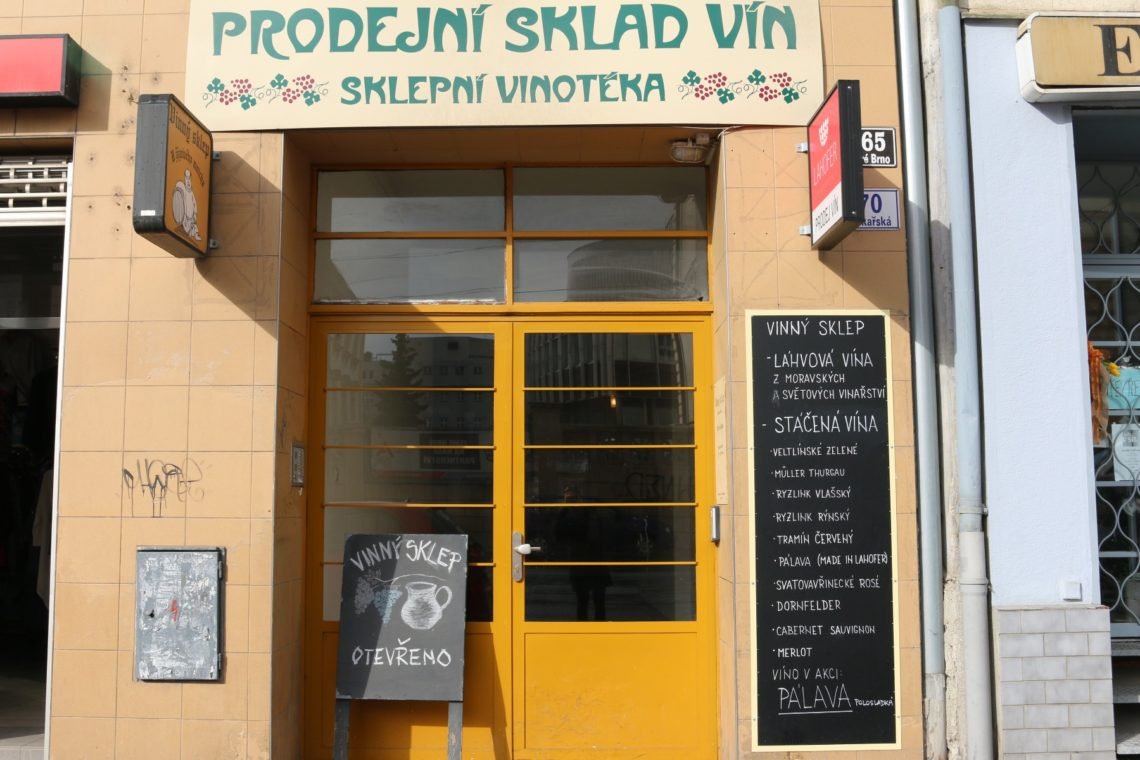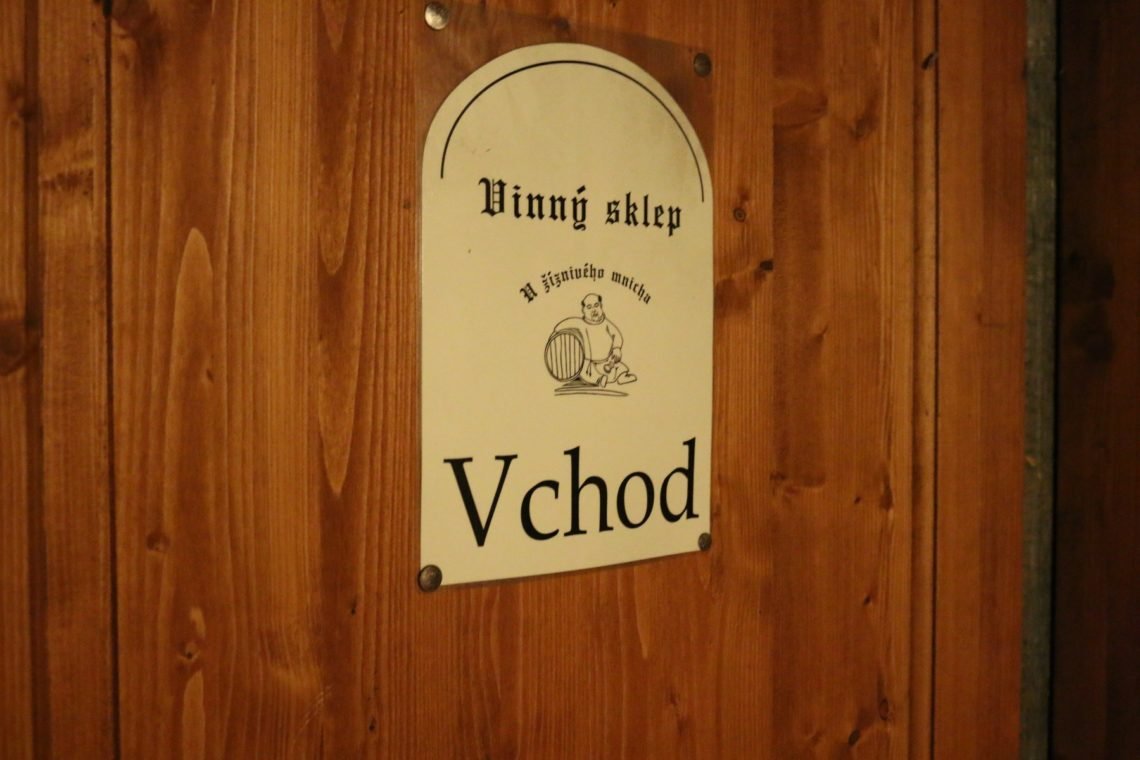The Vinotéka
The Czech vinotéka seems to be undergoing a 21st century identity crisis, thus revealing a major split between tradition and modernity. From what I have experienced so far in Brno, there are two versions of the Czech vinotéka, often referred to as a Vinný Sklep, or wine cellar.
The first is unique to the Czech Republic and walking inside is truly a step back in time. This type of underground vinotéka, considered by some to be more of a “wine pub,” does not feature a modern pub’s massive windows looking out onto the street. For the large majority of vinotékas, there is no cell phone service, which for me is a welcomed pause from the outside world. They offer a glimpse into the history of Moravia, with cellar hands who maintain the building’s traditional charm, wine offers and ambiance. They are a safe haven for private conversations, hushed voices and amicable exchanges.
Interior of Vinný Sklípek Vinárium
The second version of the vinotéka feels more like a modern day wine bar, with cushy, bright furniture, sleek lighting and racks of new world and old world wines, representative of a global shift of wine appreciation.
They offer E-Shops, where clients can easily select from the wines they prefer and have them shipped directly to their door. These vinotékas embrace a more youthful, design-based approach, with a diverse and exotic wine selection, and attract a wider and perhaps, younger tech-savvy audience.
Interior at Just Wine
Enjoying a glass of Clos Troteligotte K-Pot Malbec at Just Wine
Both vinotékas have their purpose and place in Brno. Yet as a foreigner and expat, I am inherently drawn to the more traditional vinotéka, for its charm, mystique and ambiance. Imagine an underground cavern with Moravian wine bottles displayed on wooden racks and a tasting room featuring various barrels on tap.
Now imagine dozens of these cellars, with some dating back to the 14th century, scattered throughout the city’s stone streets.
The current proprietors strive to maintain this long established aesthetic and the building’s historical character, rooted in centuries of Moravian wine tradition. They are keen to maintain traditional values and a familiar, comfortable atmosphere. A punch-clock, still in use today, reminds me of the older generations who transitioned from former Communist rule.
Surely the original proprietors could not have imagined this present day scenario of a young sommelier from New York traipsing through the hallowed stone arches, later to write about the experience in her wine blog.
These vinotékas are generally underground, so the main entrances are not found directly on the street. Instead, there is an apartment style buzzer just outside of the building. After a quick ring, the five second pause builds anticipation, as you wait patiently for the cellar hand to unlock the door and initiate the descent: a narrow hallway leads to a set of stairs and the 55 degree cellar temperature quickly gives you the goosebumps.
Hallway leading to the interior of Vinný sklípek U Žíznivého mnicha
Interior of Vinotéka U Tří Knížat
Further archways guide you to a tasting room hidden from the pedestrians outside. Oftentimes there is not just one room, but a labyrinth of hallways leading to multiple chambers, cellar rooms and private, hidden nooks, all of which have been carved into the stone decades, sometimes centuries ago.
Unlike wine shops in the United States that offer dozens, if not hundreds of wines from around the world, the majority of these underground vinotékas here choose to offer wines from just one or two wineries. In contrast to wine distribution here, many of the wine shops in the US are unable to sell directly from the winery to the consumer. They are obliged to go through a distribution channel to import and sell specific brands of wine. Yet here, it is the Moravian winery that is oftentimes the proprietor of the vinotéka in the city center, essentially creating their own tasting room and bar in Brno. And if the desired wine isn’t available in the city center, the Brno residents oftentimes prefer to make the 45 minute drive to the wineries, thereby avoiding any wine store price markup.
Today, it seems as if the newer venues are rejecting tradition and embracing globalization. They offer a different type of ambiance, that of a generation finally lifted from communist rule, a generation rather forging a globally diverse culture. The brightly lit signs are readily visible from the street and the entrances are easily accessible, summoning their customers in for a glass.
The music playing reflects the staff and customers- hip, funky and modern. This type of vinotéka is reminiscent of the wine bars in the United States, with updated, colorful furniture and an ambiance reflective of an expanding wine culture. The wines hail from both old and new world regions: Romania, Argentina, Spain, Italy, France, Austria and Georgia, just to name a few.
When my husband and I first arrived in Brno, the idea of a traditional vinotéka was very foreign to us. Yet we were up against the fast approaching winter season and knew we had to quickly find our go-to local wine shops. We always enjoy sharing our daily woes over a bottle of wine and were concerned about our wine supply as this brutally cold winter slowly crept towards central Europe. After all, winter in Brno was nothing like winter in North Carolina. We were facing below freezing temperatures, blustery winds and just a few, sparse hours of sunshine each day. After the first week of settling in, we realized that we needed ample supplies for our upcoming ‘hibernation period.’
As fate would have it, we didn’t have to walk too far, as the closest underground vinotéka is about 20 paces from our front door. Our first experience was rather intimidating. We pressed the buzzer on the street and after entering, were disoriented and confused as to where to find the actual entrance.
A sign reading ‘Vchod’ had us assuming it meant entrance, and sure enough, after passing through the arched wooden door, found our wine cellar heaven.
We approached the cellar hand and asked for two glasses of wine, and took our seats at a dimly lit booth. Next to us were two older gentleman conversing in soft tones, sipping from tiny glasses of white wine. A plate of sausages and pickled Havarti cheese lay before them, untouched; their conversation was of primary concern.
Jim and I enjoyed our glasses of Dornfelder, a red wine varietal that offers aromas of black plums, black cherry and baked figs, with a medium bodied palate and soft acidity. In my previous experience with Dornfelder in North Carolina, many were made to be quite sweet, with 9% Alcohol by Volume and a high percentage of residual sugar.
Yet this Dornfelder was fermented to be totally dry, with only a slightly fruity palate. It may not have been the most glamorous wine, but it was pleasant, soft and easy to drink. We admired the centuries old decor while sipping our wine, contemplating the age of the brick walls and history of the building.
I have made it my mission in Brno to frequent all of the city’s vinotékas, to uncover secret gems and hopefully discover the stories behind both the old and new wine bars. I find the split between the two styles endlessly fascinating and am excited about the wine culture surrounding us here in our new city. And I plan on taking you with me!







